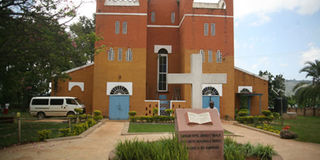A county founded on the Gospel of US missionaries

The Church of God’s Kima cathedral can sit up to 1,000 worshippers. PHOTO/HEZRON NJOROGE
The missionaries came, conquered, built churches at Kima in Emuhaya and Kaimosi in Hamisi and set up schools for both girls and boys.
Big names who pioneered in education are associated with the early arrival of missionaries. Paul Agoi, a chief in Maragoli, educationists Solomon Adagala and Mathew Mwenesi, church leader Thomas Lungaho and trade unionist David Mulindi are some of the well known families who embraced early education.
Later, those who were dissatisfied with the missionaries’ version of the Gospel founded their own churches. And they are many, close to 20, littered all over, from among the Tiriki, Maragoli and Banyore.
At Kaimosi, the Quakers arrived from America in 1902 and pitched their tents. Other Americans who came via South Africa arrived at Kima in 1905 and established the Church of God.
“Had they not come, we would not have had early education, perhaps we would still be the bushmen that we were before they arrived,” said Mzee William Okwemba, whose elder brother, Dr Arthur Okwemba, became the first Kenyan medical doctor.
The Quakers founded Kaimosi Friends Mission, then a boys’ school, the precursor of Friends School, Kamusinga, that was later transferred to Bungoma.
With this they wielded — and still do — a lot of influence in the county. A tour around the region reveals that almost everything in Tiriki and Maragoli is Friends; churches, schools, hospitals and clinics are all named Friends.
Kaimosi is the Friends’ Corner, an island of institutions without a town, all built in a forest: Friends African Mission, Friends Theological College, Friends Kaimosi Girls High School, a teachers’ training college and a campus of Masinde Muliro University.
There in the forest, in 1926 they build the first GBS, as it was then called — meaning Girls Boarding School – older than Nyabururu GBS in Kisii which was started by Catholic missionaries in 1932.
The influence of missionaries was behind the many educated men and women from the two communities. At Kima, next to Bunyore Girls High school 60 kilometres to the west of Kaimoisi, is where the Church of God built its mission.
A big plaque on the church that can seat 1,000 worshippers at a time details how it all began. Next to it is a Confession Room where people go to admit to their sins.
The church was founded by Mr A. W. Baker before three missionaries — Robert Baker, Mable Baker and Henry Kramer — arrived in 1905 from South Africa.
“They avoided Maseno because the Anglican missionaries had settled there,” said Mr Okwemba. Land was set aside by a chief from Bunyore known as Otieno.
One of the early converts was Johano Owenga who helped to preach in the vernacular, a language which the missionaries also learnt fast.
The plaque states that the church was built thanks to funds donated by Bunyore, Kisa, Kakamega and Butsotso.
It was built on land belonging to the Abamutete sub-clan of the Banyore people and for this the area has had various names, plus a common saying among the people.
Ebungeresa is one name that has stuck, meaning home of the English language. It gave the area a head start over others and it is no coincidence that it produced the first doctor, and a clinical officer called Kwendo.
Kwendo’s son, Eric Khasakhala went on to become the first Emuhaya MP having benefitted from early education at Kima.
The dominance of American missionary churches limited the Catholics and Anglicans to Maseno in Kisumu and Mukumu in Kakamega.
Even today, there are fewer Catholic and Anglican churches in Vihiga. The Salvation Army is another American sect with influence in Vihiga.




